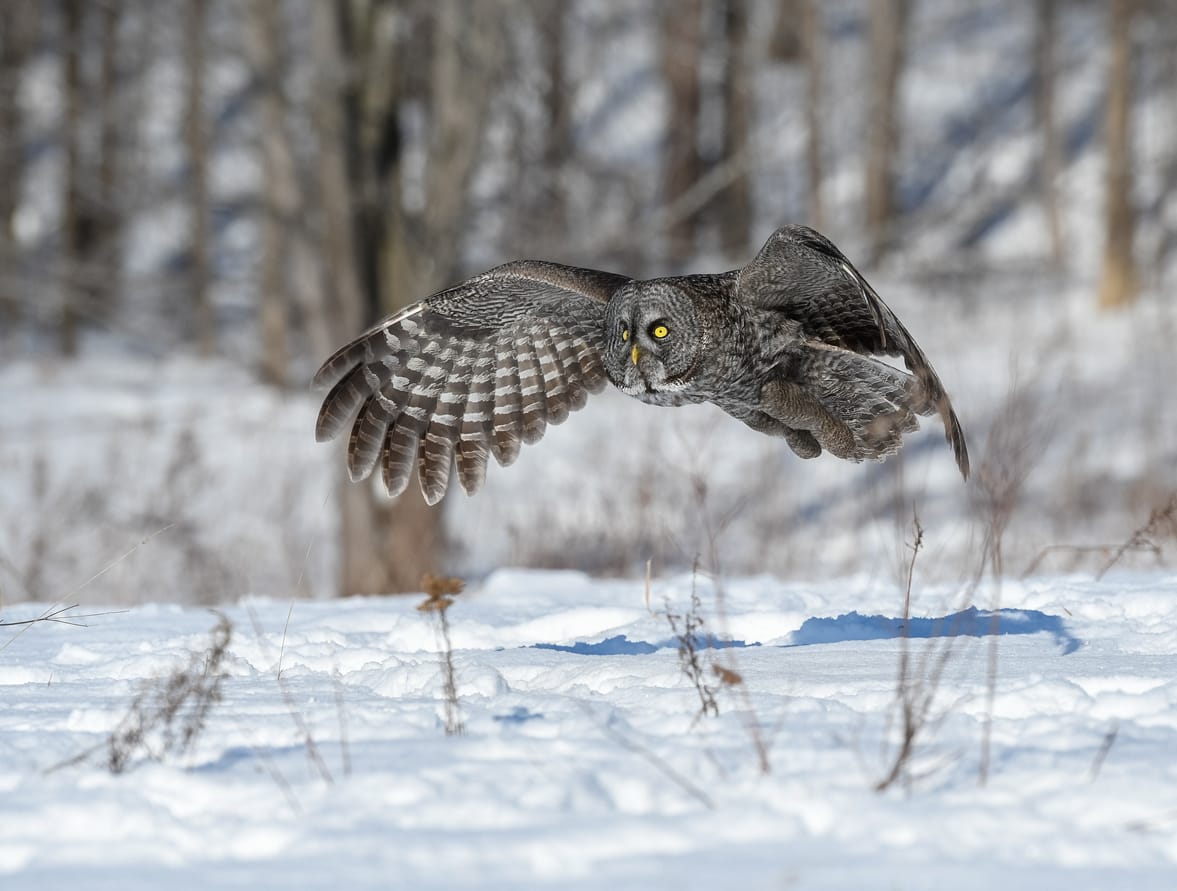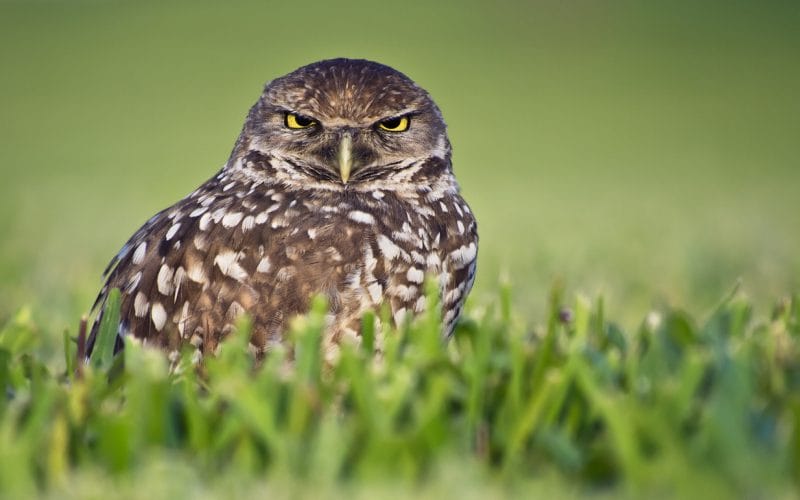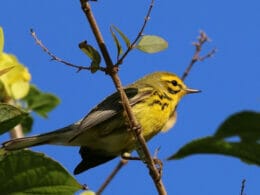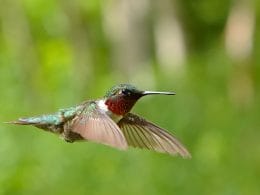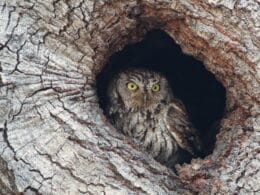Maine has many remarkable tourist attractions. One of the main ones is the extent of wildlife in the state.
Many owl species call Maine home. And more still come to visit every year. If you’re in the Pine Tree State, looking for owls, here’s a guide on the 11 different owl species in Maine.
1. Great Gray Owl

- Scientific name: Strix nebulosa
- Length: 24 to 33 inches
- Weight: 32 to 39 ounces
- Wingspan: 55 inches
- Average life span: 12 to 20 years
- Status: Least concern
The Great Gray Owl is the largest owl in the world, but most of that size is just feathers. They have silvery-brown feathers that cover their entire body.
Top Tip: Adult Great Gray Owls do have a pop of color. Their eyes are bright yellow and they have orange beaks.
They mostly like to live in colder areas, and you can scarcely see them in Maine. The cold provides a great environment for them to hunt and breed.
Great Gray Owls mostly feed on small rodents and they prefer voles. You can find them hunting in large, open grasslands.
When hunting, the Great Gray Owl will perch on a low branch waiting to pounce. But you can sometimes find them flying close to the ground looking for food.
To help them hunt, they have exceptional hearing. Great Gray Owls can hear prey even if they’re hiding under two feet of snow.
In the wild, they tend to be quiet birds. They can make deep ‘who’ sounds but only do it around their breeding ground.
These owls are among the more friendly birds of prey, but that doesn’t mean it isn’t a fierce hunter.
2. Boreal Owl
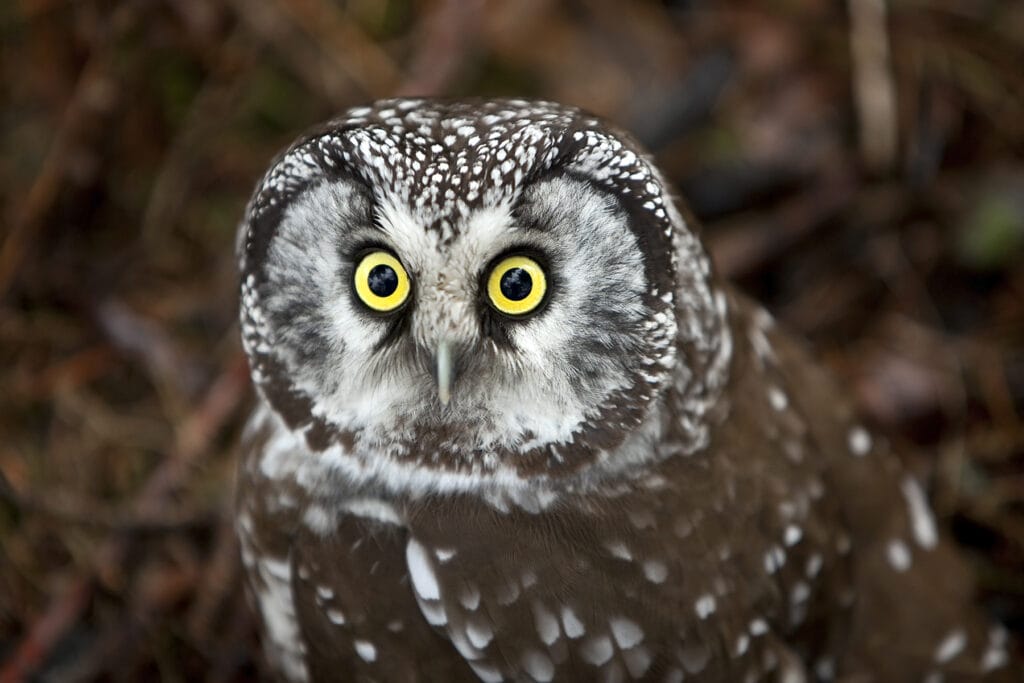
- Scientific name: Aegolius funereus
- Length: 8.3 to 11 inches
- Weight: 3 to 7.6 ounces
- Wingspan: 24 inches
- Average life span: 10 to 16 years
- Status: Least concern
You might come across the Boreal Owl in conifers or forests. They mostly live in colder areas (they are also very common in New Jersey)
The Boreal Owl can sometimes spend the winter in Maine. It’ll spend a few months hunting and then move back to its breeding ground.
It has brown feathers with white flecks on the main part of its body. But, on the face, the Boreal Owl has white feathers and a yellow beak.
Boreal Owls make almost no sound, even their flying is silent. They’re silent but deadly. Boreal owls like to hunt voles and insects.
3. Great Horned Owl
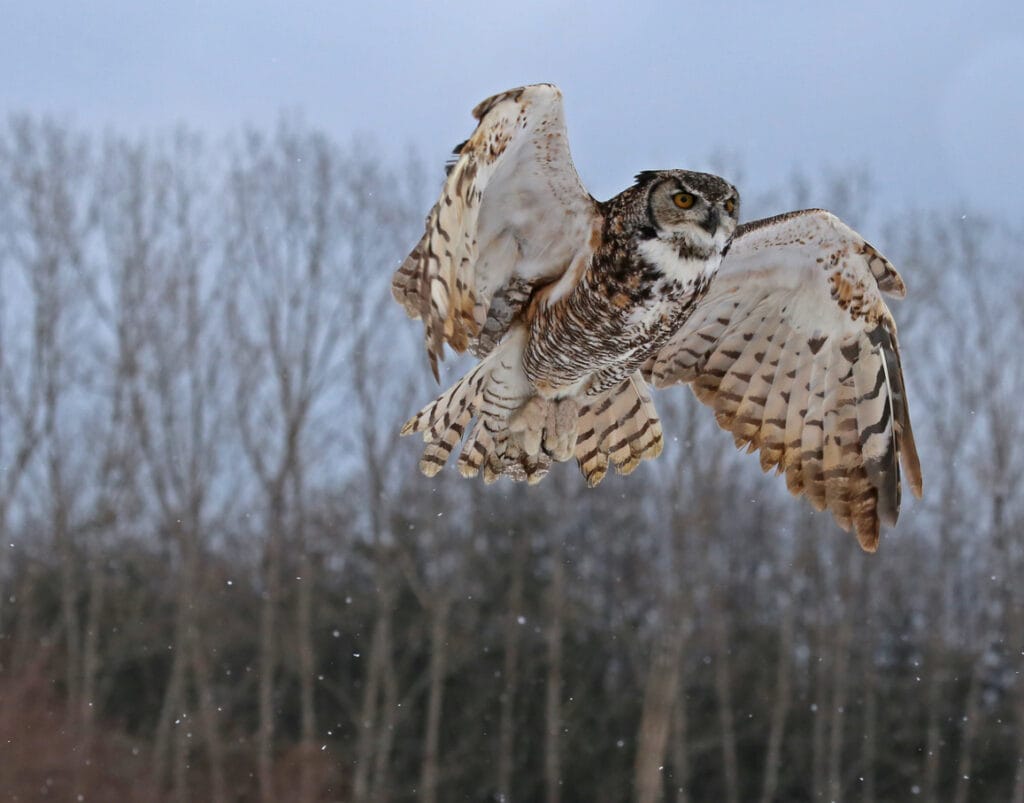
- Scientific name: Bubo virginianus
- Length: 18 to 24 inches
- Weight: 32 to 88 ounces
- Wingspan: 57 inches
- Average life span: 15 to 25 years
- Status: Least concern
If you’re looking for Great Horned Owls, you don’t have to try hard. These formidable birds of prey are the most common owls in Maine and you can see them all year.
Great Horned or Tiger Owls are terrifying apex hunters. No prey is off-limits. They can hunt down rabbits, squirrels, and sometimes even ducks.
They have long ear tufts at the top of their heads that look like horns. Depending on where the owls are nesting, they can have different colored feathers. The feathers can be gray or brown.
Top Tip: When males are ready to mate, they’ll go nest hunting. They find an abandoned nest and fly above it.
To lure a female in, the male will stomp on the nest to get her attention. Then, if the female accepts the invitation, they mate for life.
They’re also great co-parents, taking care of the young together and keeping them safe.
4. Long-eared Owl

- Scientific name: Asio otus
- Length: 14 to 16 inches
- Weight: 8 to 15 ounces
- Wingspan: 39 inches
- Average life span: 10 to 30 years
- Status: Threatened
Long-eared Owls are smaller than Great Horned Owls, but they can be just as deadly.
In Maine, you can find them during spring and summer in their habitat. They like to nest next to open grasslands in abandoned nests.
Long-eared Owls’ most notable feature is their long ear tufts. Their ear tufts are much closer together than the Great Horned Owl. The ear tufts also stand up-right,
Their main body has dark feathers, while their faces are orange-red, with two white vertical lines going down the middle.
When the two vertical lines on the face meet, they can make the owl look like it has a mustache.
These owls spend most of their time in dense conifer stands. This is where they find most of their food.
To hunt, the Long-eared owl will fly over an open space looking for prey. We call this hunting on the wing. They can spend hours in the air searching for voles. Once they find them, they slow down and pounce on the prey.
5. Short-eared Owl
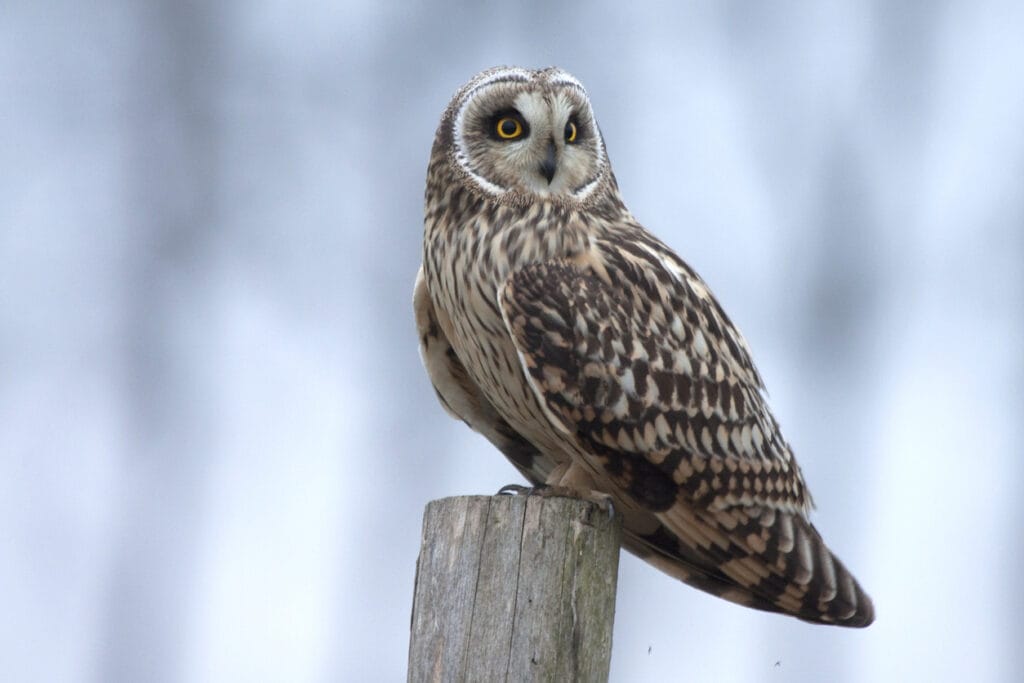
- Scientific name: Asio flammeus
- Length: 13 to 17 inches
- Weight: 7 to 16 ounces
- Wingspan: 40 inches
- Average life span: 8 to 12 years
- Status: Least concern
If you haven’t already guessed, the Short-eared Owl is like the Long-eared owl in many ways. They also spend their spring and summer in Maine.
The main difference in their appearance is their ears tufts. The Short-eared Owl has much shorter ear tufts. They also have pointier wings and more color contrast.
Short-eared Owls have dark brown feathers on their back and cream feathers on their belly.
Unlike most other owls, Short-eared Owls like spending time in the sun. They’re diurnal and can hunt night and day.
Author Note: When you see them flying, you’ll notice they have a ‘floppy’ fly pattern. This is because of the shape of their wings.
The wings give them an edge in the winter. Short-eared Owls can puff up to help them stay warm.
They’re nomads and like to migrate and follow the warm weather. But they’ll also follow prey, even if it’s cold. Mostly, they hunt prairie voles, but they’ll eat whatever they can find.
6. Snowy Owl

- Scientific name: Bubo scandiacus
- Length: 24 to 30 inches
- Weight: 30 to 70 ounces
- Wingspan: 65 inches
- Average life span: 10 to 17 years
- Status: Vulnerable
Snowy Owls can survive in all sorts of climates, but they prefer the cold. They can sometimes visit Maine in the winter, but very rarely.
To camouflage in their environment, they have white feathers with dark spots. The spots vary greatly in size and density.
Females usually have many dark spots on their feathers, while males have few spots and sometimes none at all.
Since they spend most of their time in the cold, Snowy Owls have special adaptations. They have long feathers on their legs to help them walk in the snow.
Snowy Owls don’t have a stable nesting ground. Throughout the year, they’ll move around, following food.
They can eat any small rodent or bird that comes their way, but their favorite prey is the lemming. To hunt in the dark, Snowy Owls have exceptional yellow eyes that can see a mile away and 270° around their body
It can be hard to breed in the cold, so female Snowy Owls will develop a brood patch.
The brood patch is an area with no feathers on the lower part of a female Snowy Owl. The patch gets plenty of circulation so the owl can keep its eggs warm.
7. Northern Saw-whet Owl

- Scientific name: Bubo scandiacus
- Length: 7 to 8 inches
- Weight: 2 to 5 ounces
- Wingspan: 18 inches
- Average life span: 7 to 16 years
- Status: Declining Numbers
You can find the Northern Saw-whet Owl all year long in Maine. It’s easy to tell them apart from other owls as they’re the smallest in Maine and they have dark brown feathers on their backs.
Another easy way to spot them is their call. The Northern Saw-whet makes a distinctive ‘poo’ sound.
Northern Saw-whet Owls are active at night, in the trees. So, they use their calls to communicate with each other. They also have adapted their ears to hunt at night. They’re shaped in a way to give the owl incredibly sensitive hearing.
This also comes in handy to hunt down prey in large cedars and conifers. The Northern Saw-whet Owl feeds on mice and other rodents.
Unlike most other owls, Northern Saw-whet Owls divide up their parenting duties.
The female will stay with the owlets and protect them from danger. While the male will go out hunting, prey for the entire family.
8. Barn Owl
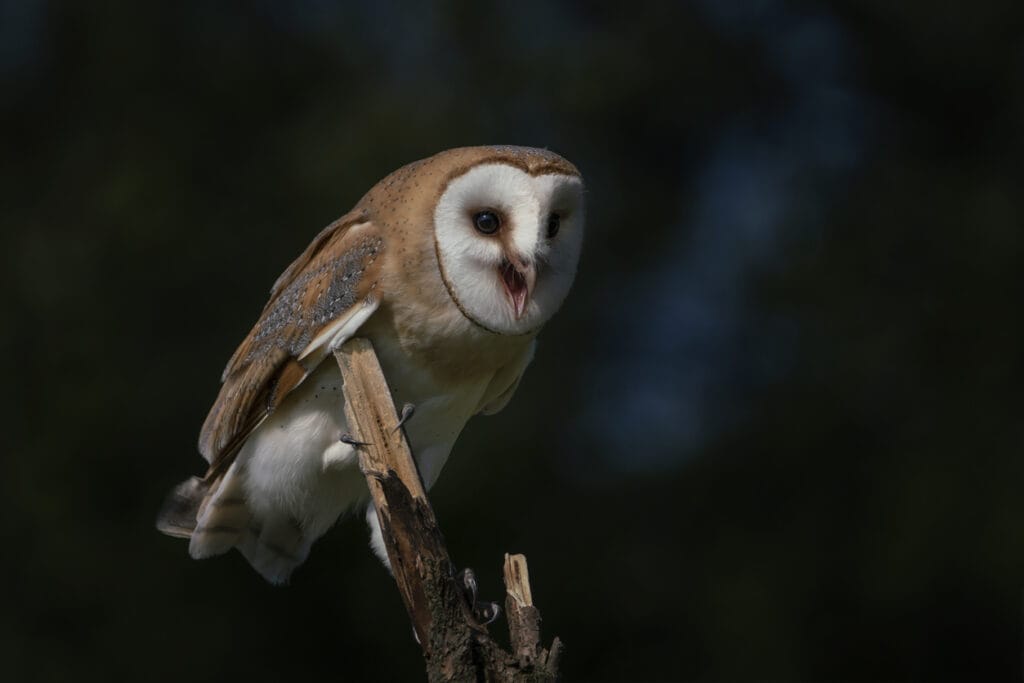
- Scientific name: Tyto alba
- Length: 14 to 20 inches
- Weight: 14 to 24 ounces
- Wingspan: 48 inches
- Average life span: 2 to 4 years
- Status: Endangered
Barn Owls are golden brown with striped feathers. Their features include dark, deep-set eyes, long legs, and a heart-shaped face.
Though, the Barn Owl’s most notable physical feature is its white, heart-shaped face.
The Barn Owls show reverse sexual dimorphism. That means that females are larger than males. Males also tend to be paler, with a golden hue.
In Maine, Barn Owls like to spend most of their time in meadows and farmlands. This is where they get their main source of food.
They like to hunt at night, and they’ll eat anything they find, including rats, mice, voles, and sometimes small birds. Because they hunt at night, Barn Owls have developed enhanced senses. They can see clearly in the dark and have a very keen sense of smell.
When it comes to sound, Barn Owls are fairly quiet. They don’t hoot and because of the shape of their winds, flying is silent.
9. Barred Owl
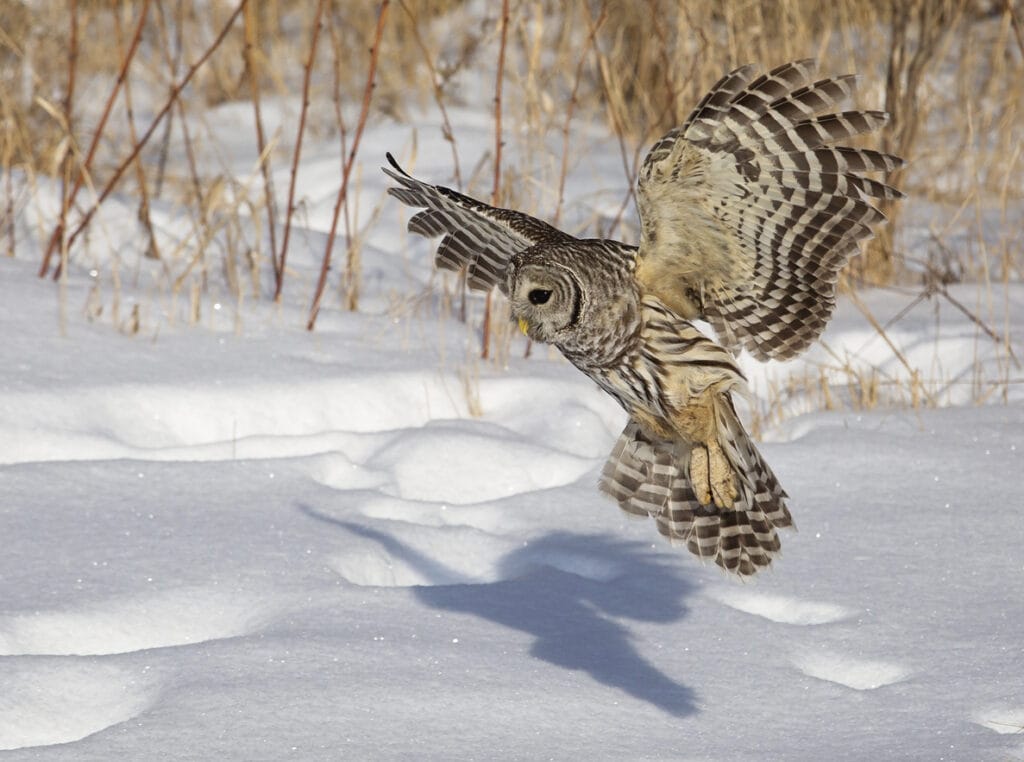
- Scientific name: Strix varia
- Length: 17 to 20 inches
- Weight: 16.6 to 37 ounces
- Wingspan: 43 inches
- Average life span: 8 to 10 years
- Status: Least concern
Barred Owls are some of the most common owls in Maine, so you’re most likely to see one in the state.
Barred Owls like to nest in woodlands and swampy thickets. Usually, they’ll nest all day and then start hunting from sundown to twilight.
If you’re looking for them, be on the lookout for stripes. They have brown and white feathers. Their backs have horizontal stripes and their bellies have vertical stripes.
Top Tip: The Barred Owl is also the only owl that nests in Maine that has dark eyes. Most of the others have yellow or green eyes.
But that’s not the only special feature of the eyes. Barred Owl eyes are extremely sensitive to light. They can pick up on the slightest movement in the branches. Even when it’s pitch black outside.
This is crucial because Barred Owls live in heavily wooded areas. That means there are branches and roots everywhere for prey to hide. The Barred Owl likes to hunt all sorts of prey. They can eat mice, squirrels, snakes, and even other owls.
10. Northern Hawk Owl

- Scientific name: Surnia ulula
- Length: 14 to 17 inches
- Weight: 8 to 12 ounces
- Wingspan: 18 inches
- Average life span: 8 to 12 years
- Status: Least concern
Northern Hawk Owls usually live in the southern part of Canada. But, sometimes during the winter, they’ll visit Maine.
This is another owl that likes to fly around during the day. You can find them perched on high trees, next to open grasslands.
They get their name from their hunting behaviors. Northern Hawk Owls have similar hunting styles to hawks and falcons.
Wrapping Up
Maine has a large variety of wildlife. Since it has many forests and large open grasslands, many animals can find a home.
If you know where to look, you can find an owl all year long. Whether you’re in a wooded area or near a lake, you might see an owl flying.
Owls are beautiful birds, but they’re also dangerous hunters. So, it’s probably a good idea to keep your distance. We hope you enjoyed our guide to the most common owls in Maine!
FAQ
To find out where recent sightings of owls have been, try eBird. You can search for the latest sightings or particular species or what has been seen in a certain area.
The Barred and Great Horned Owls are the most common in Maine.
Audubon recommends Baxter State Park as a good place to start looking for owls.




